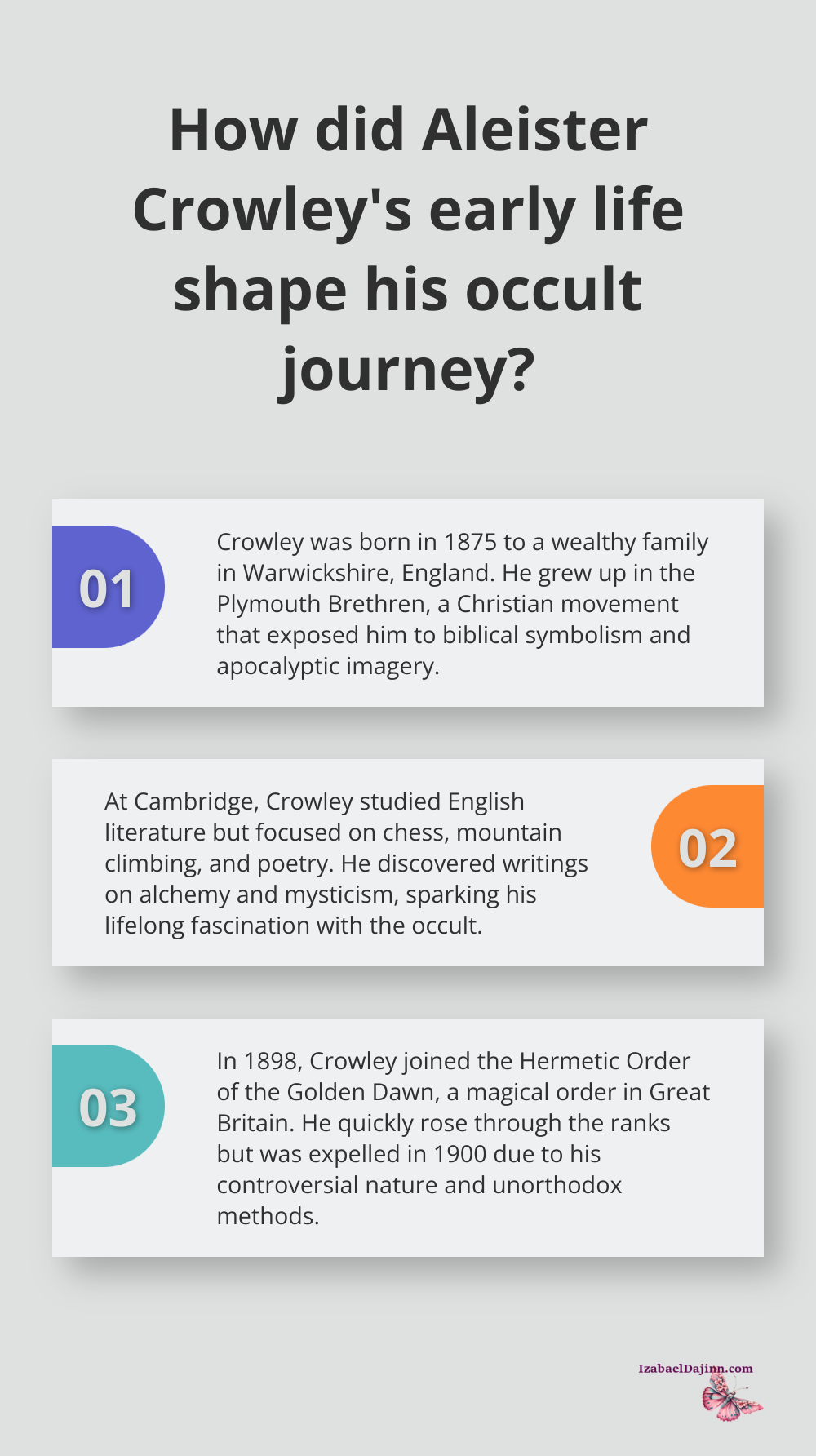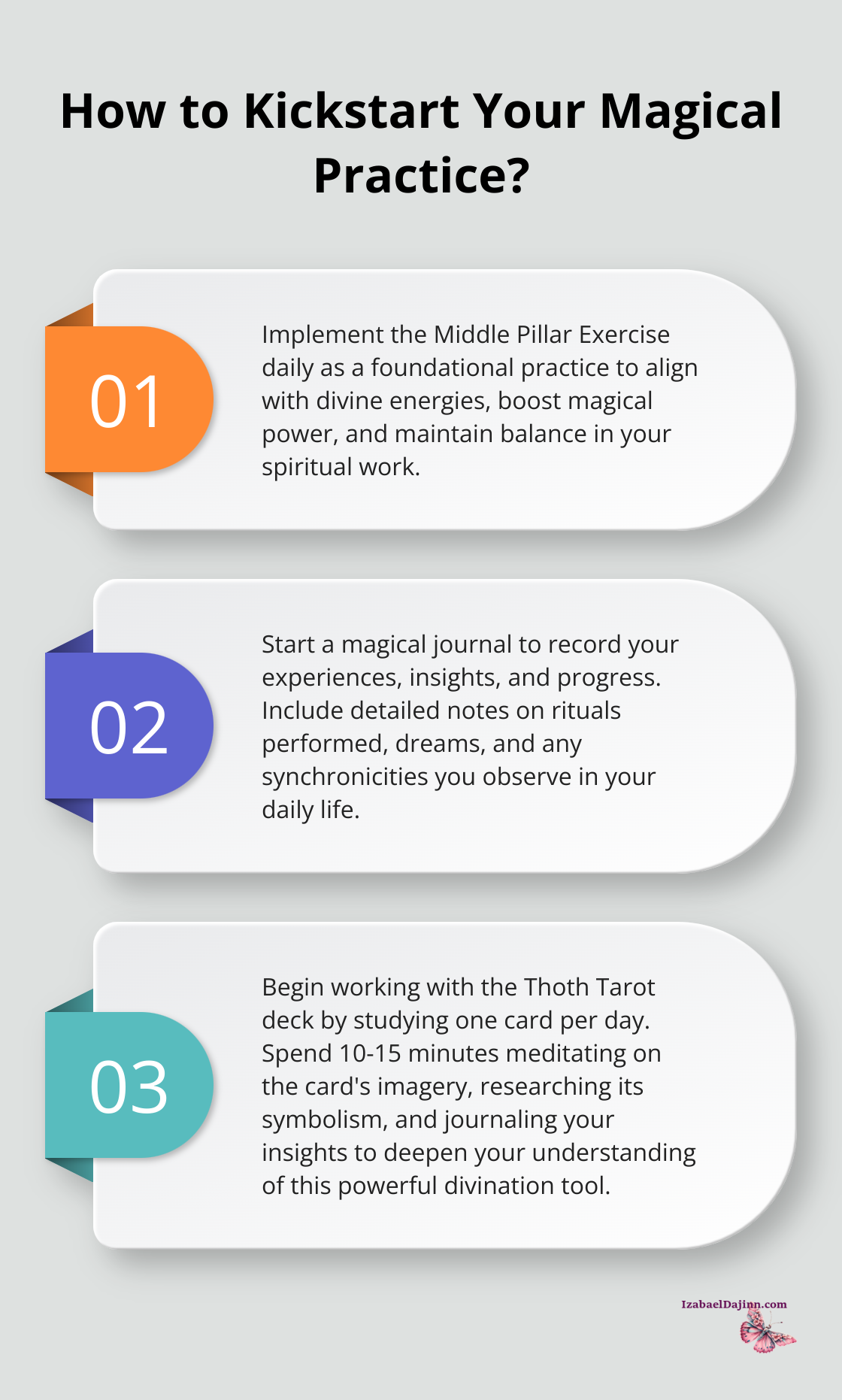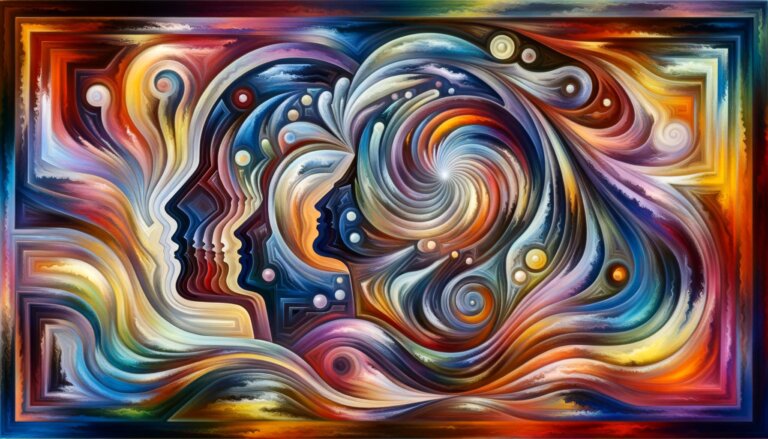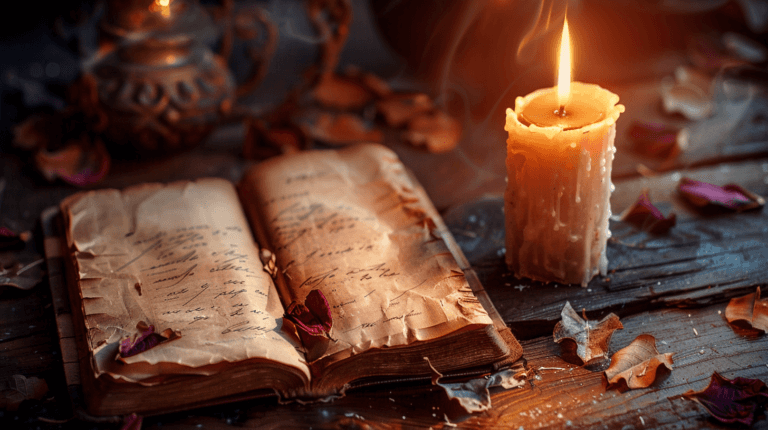Crowley’s Magical Journey: Essential Guide
Aleister Crowley’s magical journey—shaped modern occultism like no other. At Izabael’s Occult Review, we crafted this guide to explore his profound impact on magical practice.
From his early days in the Golden Dawn… to the development of Thelema, Crowley’s work continues to influence practitioners worldwide. This post delves into his life, philosophy (all that “do what thou wilt” jazz), and key magical contributions.
Crowley’s Roots: From Devout Christian to Occultist
Aleister Crowley’s transformation-that journey from a strict Christian upbringing to becoming the self-proclaimed “Great Beast 666”-is a wild ride of rebellion and spiritual exploration. Born Edward Alexander Crowley in 1875 to a wealthy family in Warwickshire, England, young Aleister grew up entrenched in the Plymouth Brethren, a Christian movement that kicked off in Ireland and England. This formative experience laid the groundwork for his later dive into the occult-marinating him in biblical symbolism and apocalyptic imagery from the get-go.
Cambridge: A Turning Point
At Cambridge, Crowley’s world just blew up-in a good way. He signed up to study English literature but seemed more consumed by chess, mountain climbing, and poetry. This is where he first stumbled upon writings on alchemy and mysticism-bam, lifelong fascination with the occult ignited. His stint at Cambridge was a pit stop; he bailed without a degree in 1898, using his cushy inheritance to globetrot and dig deeper into esoteric traditions.
The Golden Dawn: Crowley’s Occult Initiation
In 1898, Crowley jumped into the Hermetic Order of the Golden Dawn-a magical order in Great Britain, all about theurgy and spiritual development. This group gave Crowley a structured magical system and a circle of like-minded folks.

Crowley zoomed up the ranks within the Golden Dawn, flexing his muscles in magical practices and rituals. But his controversial nature and unorthodox methods? Yeah, they stirred up drama-big time. This ultimately got him booted from the order in 1900.
Practical Applications from Crowley’s Early Years
-
Explore diverse spiritual traditions-Crowley’s exposure to different belief systems gave him a broader view. Practitioners should dive into multiple traditions to enrich their magical practice.
-
Challenge established norms-Crowley’s rebellious spirit led to innovative magical theories. Don’t shy away from questioning the status quo in your own practice.
-
Network with other practitioners-Crowley’s immersion in the Golden Dawn shows the power of connection. Join occult groups or online forums to share knowledge and experiences.
-
Lay a solid foundation-Despite ditching his Christian roots, Crowley’s early religious education gave him a base. Study foundational texts and symbols deeply to inform your magical practice.
-
Blend personal experiences-Crowley’s mountaineering vibes influenced his spiritual outlook. Weave your own life experiences and passions into your magical work for a more personalized practice.
As Crowley’s journey moved from his early years to shaping Thelema, his impact on modern occultism skyrocketed. The next chapter will break down the creation of Thelema and its massive influence on magical philosophy.
How Thelema Reshaped Modern Occultism
Alright, let’s jump in. Aleister Crowley-name sound familiar?-gave birth to something wild and seismic in Western occultism: Thelema. Originating from a mind-bending spiritual episode in 1904, this system still has its fingerprints all over magical practices today. The kicker? Thelema dares you (yeah, you) to find and live out your true purpose.

The whole philosophy pivots on The Book of the Law, which Crowley claimed was dictated by an entity named Aiwass. Think of this text as the lodestar for Thelemites, introducing the famous maxim: “Do what thou wilt shall be the whole of the Law. Love is the law, love under will.” Now, before you think it’s a license to go all-out hedonistic, hold up-this principle is all about aligning your actions with your higher purpose, your True Will.
Practical Applications of Thelemic Principles
So how do these lofty ideas cash out in real life? Here’s the breakdown:
-
True Will Discovery: Meditation and self-reflection aren’t just fluffy recommendations. Regular practice helps you uncover your authentic purpose. A popular go-to? The Liber Resh vel Helios ritual. This daily practice involves greeting the sun four times-morning, noon, evening, and midnight.
-
Banishing Rituals: If negative energies were roomies, you’d want them evicted, right? The Lesser Banishing Ritual of the Pentagram, fine-tuned by Crowley, is your broom. Done daily, it sweeps away the bad vibes and sharpens your focus.
-
Magical Record-Keeping: Crowley was a big fan of journaling. Whether you’re casting spells or just reflecting, keeping a detailed diary tracks your progress, captures those “aha” moments, and helps you spot patterns in your magical journey.
The Aeon of Horus and Its Impact
Crowley dropped the mic with his proclamation of the Aeon of Horus-a new spiritual age. Translation? Humanity is stepping into an era of self-realization and individual empowerment. Here’s what that means for you:
-
Embracing Change: The Aeon of Horus is all about adaptability. Keep reassessing and tweaking your magical practices to stay aligned with your evolving insights.
-
Child-like Wonder: Horus is the child god, the symbol of fresh starts. Approach your practice with curiosity, like you’re seeing it all for the first time.
-
Balancing Opposites: Horus stands for the union of opposites. Integrating seemingly contradictory elements in your magical work creates a more rounded, holistic practice.
Thelema’s Wider Influence
Way past Crowley’s original posse, Thelema’s influence has spread like wildfire. Modern magical orders, like the Ordo Templi Orientis (O.T.O.), keep Thelemic teachings alive. The Gnostic Mass, a central ritual of the O.T.O., gives a structured way to engage with these principles as a group. Picture a ceremony with five officers, including a Priest.
Looking to go deeper? Grab a copy of Crowley’s Magick Without Tears. It’s packed with practical advice on everything from building rituals to ethical conundrums in magical practice.
Now, let’s be real-some of Crowley’s ideas have not held up well over time. So, a critical eye is your best friend here. Many modern practitioners tweak Thelemic concepts to fit today’s ethical standards and scientific perspectives.
As we dig into Crowley’s major magical works next, we’ll get a better grasp of how these Thelemic principles play out in specific rituals and practices. When applied thoughtfully, these tools can become powerful engines for personal transformation and magical growth. Buckle up-we’re just getting started.
Crowley’s Magical Arsenal: Tools for Modern Practitioners
The Thoth Tarot: A Window to the Subconscious
So, here’s the deal with Thoth Tarot deck, crafted by Aleister Crowley and artist Lady Frieda Harris-it’s like, next-level esoteric. This isn’t your grandma’s Tarot deck. Crowley jazzed it up with Thelemic principles, a hearty serving of Kabbalah, astrology, and a dash of alchemy.

How to use this bad boy?
-
Get into the symbolism: These cards are dense… like, layers-on-layers dense. You’ve got to marinate in each card, dig into the research, and let the imagery sink in.
-
Dive into divination: The Thoth Tarot isn’t for quickie readings. Start simple with three-card spreads and, as you get comfy, move on to the complicated stuff.
-
Pathworking: Think of the cards as interactive VR-visualize yourself stepping into the scene, play around with the elements.
Magick in Theory and Practice: A Practical Guide
Crowley’s magnum opus, Magick in Theory and Practice-this text is like the Swiss Army knife of ceremonial magick. It’s chunky but chock-full of practical techniques:
-
The Middle Pillar Exercise: This isn’t just a ritual-it’s your magical daily multivitamin. Aligns you with the divine, boosts your mojo, and keeps you balanced.
-
Assumption of God-Forms: Crowley gives you the 411 on impersonating deities or archetypes. Get into character, and you’ll pump up your power and score insights into your magical path.
-
Sex Magick: Yep, Crowley’s got a chapter on harnessing sexual energy. Powerful stuff, but handle with care (and ethics).
Numerical and Symbolic Foundations
Crowley’s 777 and The Book of Lies-these are your sacred cliff notes:
-
The Book of Lies: Misleading title, right? This one’s packed with truths hidden in wordplay and symbols. Meditate on random chapters-it’s like a spiritual brain teaser.
-
777: Your go-to for magical correspondences. When designing rituals and spells, cross-reference with 777 to nail your symbolism.
Getting into this stuff requires, well… commitment. Start small-daily Tarot meditations or the Middle Pillar Exercise. Once you get the hang of it, layer in more elements as you deepen your understanding.
Pro tip: While Crowley’s foundation is solid, pair it with modern resources that factor in today’s ethical standards. Magic isn’t a museum piece-it’s a living, breathing tradition. Crowley’s work is your launchpad, not the finish line.
(Note: Crowley’s work is influential, but scrutinize it. Make sure it vibes with modern ethics and your personal beliefs.)
Final Thoughts
Aleister Crowley’s magical journey-yep, the guy who practically wrote the magical playbook-transformed modern occultism. His work, from Thelema to the Thoth Tarot, is a powerhouse of mystical insights. Crowley’s teachings? Still got juice, offering practical wisdom for personal growth and magical flair.

Many modern-day wizards and witches? They’re putting their own spin on Crowley’s ideas to fit with today’s vibe. This chameleon-like quality lets his work morph and stay relevant in our ever-changing world. Crowley’s methodical approach to magic gives a structured playbook to those wanting to level up their magical game.
Looking for some hands-on wizardry? Izabael’s Occult Review serves up a buffet of spells and magical services. We’re tapping into ancient mystical tricks to help folks tackle life’s grind (and spice up their everyday). Crowley’s legacy-it’s a reminder of the deep, intricate nature of occult studies, pushing practitioners to carve out their own magical paths.






